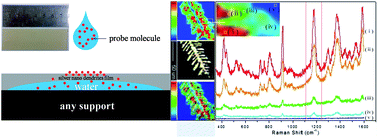Silver nano-dendritic crystal film: a rapid dehydration SERS substrate of totally new concept
Abstract
This work provides an improved new electroless galvanic deposition method to fabricate and assemble silver nano-dendritic crystals (SNDC) to be a uniform and flat film on most desired solid surfaces. This SNDC film is shown to be suitable as a new rapid dehydration surface enhanced Raman scattering (SERS) substrate, which overcomes the severely limited scope of existing SERS techniques in practical applications for solution detection. Scanning electron microscopy (SEM) characterization confirms that the SNDC film is composed of many layers of SNDCs in a stacked microcosmic structure. This structure provides the SNDC film with a large number of internal interspaces, and thus liquid can rapidly infiltrate into the SNDC film. The result of SERS mapping shows that a significant number of probe molecules are filtered out onto the silver SNDCs on the film surface. These characteristics indicate that the SNDC film can function as a molecular filter, which can conveniently separate probe molecules from the test specimen. The SERS spectra and mapping results have demonstrated a significant SERS enhancement and the excellent reproducibility of SNDCs, and are in close agreement with finite different time domain (FDTD) simulation. The combined effects of rapid water permeability, effective molecular filterability, dramatic SERS sensitivity improvement as well as reproducibility allow convenient, real-time SERS applications.


 Please wait while we load your content...
Please wait while we load your content...